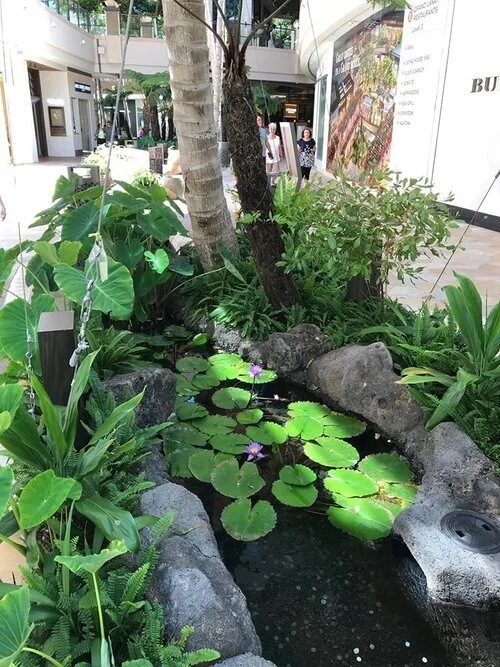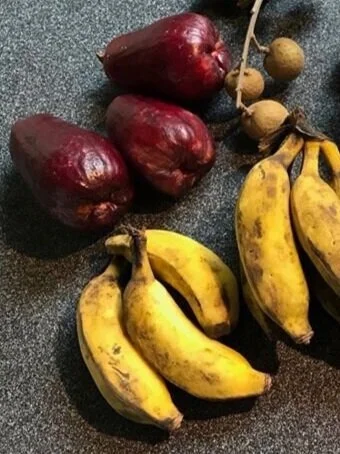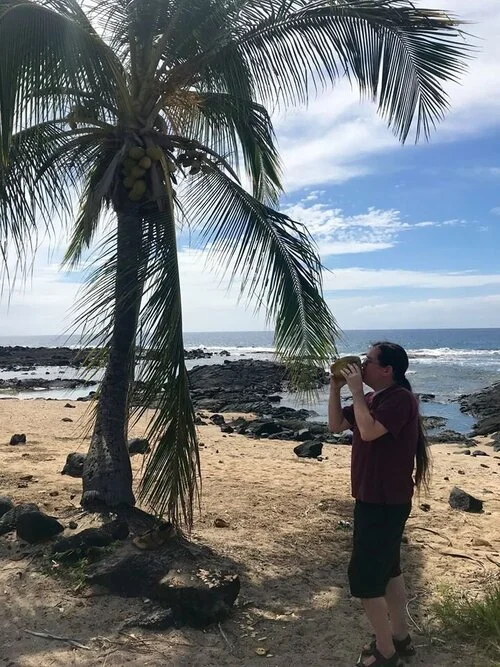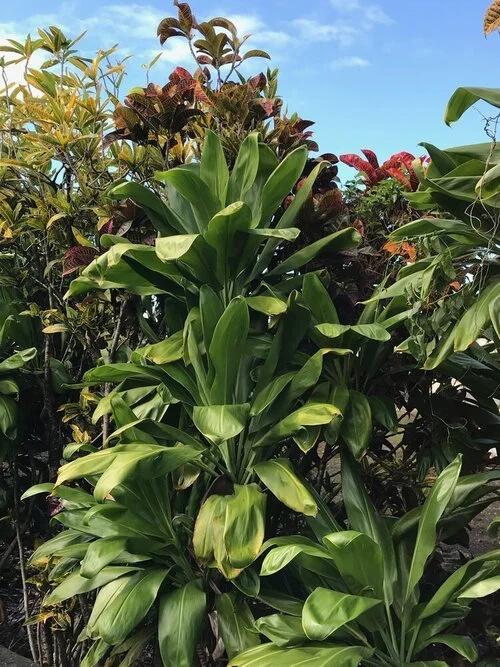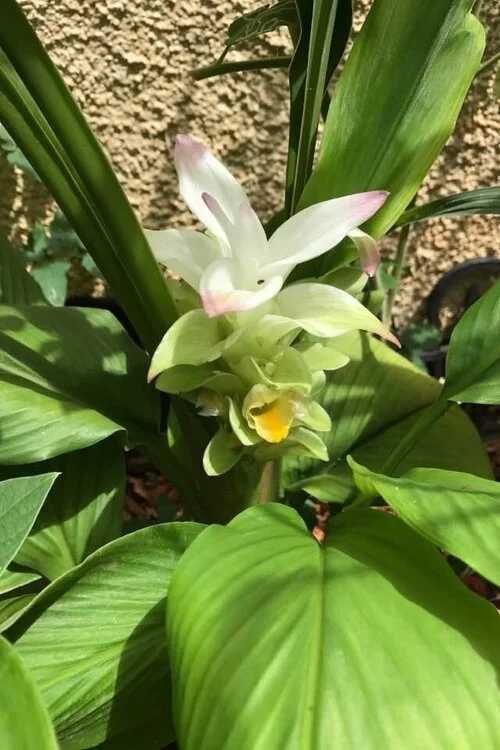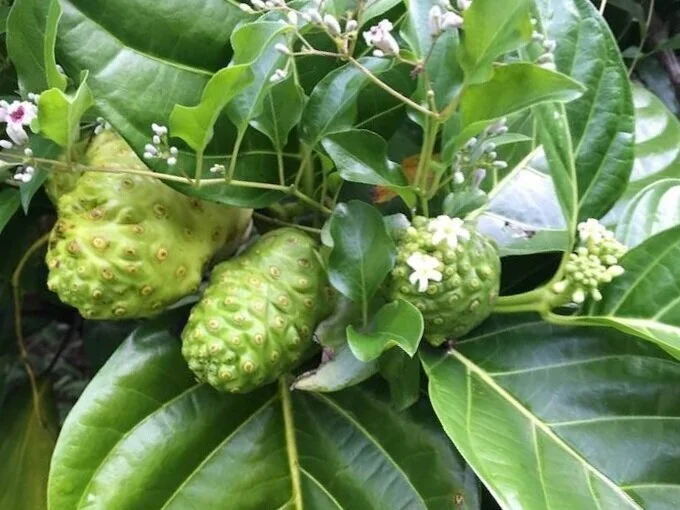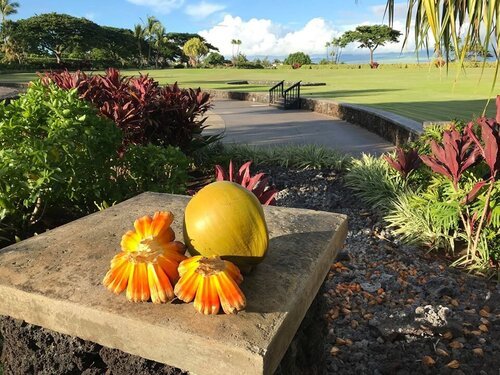
Canoe Plants for the Home Landscape
What are canoe plants?
When we picture Hawai’i, we envision luxuriant foliage with giant, verdant leaves and chaotic blasts of colour. What most people don’t realise is that these striking plants are almost invariably not native to these islands. Many of the brightest, most eye-catching plants were brought here within the last century, but a very special few were brought here over a thousand years ago by the Polynesians. This group of plants have accompanied people as they settled the tropical, remote islands. All of them are very useful, some as food, some as medicine, and others as raw materials for crafts and building. Given the Polynesians and other Pacific peoples travelled the vast distances between islands on sophisticated sailing canoes, this raft of plants has been dubbed ‘canoe plants’.
Some of the approximately 35 types of canoe plants are quite renown. For example, breadfruit (Artocarpus altilis) was made famous by the infamous Mutiny on the Bounty. The paper mulberry (Broussonetia papyrifera)’s bark is used to make kapa (tapa) cloth. ‘Awa (kava) is a well-known, lightly-intoxicating concoction made from the root of Piper methysticum. Bananas, coconuts, bamboo, and sweet potatoes are also among the canoe plants, and need no introduction.
In addition to their usefulness, many of the canoe plants make beautiful additions to your landscape. Given they have been growing here for over a thousand years, they are known to be suited to the local climates. Some of the canoe plants are among the most dramatic and instantly-recognisable flora in Hawai’i. Here are some of those that are best-suited to use in home landscapes listed by scientific name, Hawaiian name, and English name.
A fallen breadfruit leaf.
The breadfruit tree was made famous by the misfortune of Captain William Bligh during the infamous Mutiny on the Bounty. Even without this fame, the ‘ulu tree is an extremely beautiful, exotic-looking, very tropical tree. Its large, rough leaves grow to over a foot long and look like giant leaves of the red oak
This mulberry relative grows a pyramidal to round crown and bears fruit about the size of a husked coconut. The fruit are edible young or ripe; the riper the fruit, the softer and sweeter the taste. Breadfruit gets its name from its use as a potato-like staple food in the Pacific. This is a most dramatic tree and really brings the Polynesian look to your yard. The leaves and fruit are often stylistic motifs on Hawaiian quilts.
Bambusa vulgaris, ‘ohe “bamboo”
Bambusa vulgaris cv. ‘Vittata’ in Hilo.
Bamboo is one of those famous plants that needs little description. There were two species of bamboo that the Polynesians brought to Hawai’i, Bambusa vulgaris and Schizostachyum glaucifolium. Both of these grow to a rather large size – up to 75 feet in height with culms (canes) averaging four inches in thickness. These species of bamboo grow in clumps and do not spread throughout your garden. They grow best in full sun, but can handle some shade when young. The culms are useful in construction and crafting, and can be eaten when very young and cooked. In addition to being useful as a raw material, the hollow internodes of the culms were used to store and carry water. On a windy day, the sound of the wind through a mature bamboo plant can be quite melodic.
Cocos nucifera, niu, “coconut”
Coconuts will sometimes sprout and grow for a while without even being planted.
Of all the plants growing in Hawai’i and the Pacific, the coconut is the most iconic. The local cultivar, the Hawaiian Tall variety, is the palm that graces the beaches of the resorts and all around this tropical archipelago. It grows a tall trunk that frequently leans and curves, bringing the scenery of the seaside to your home. The Hawaiian coconut will tolerate poor, sandy soil and drought, but does better in rich, moist soils. The coconut is a fairly-fast, large-growing palm and will quickly outgrow tiny, urban gardens, but given enough space, it is hard to match a coconut palm in tropical, aesthetic beauty. It is important to site your coconuts carefully, as falling mature coconuts can be deadly – do not plant them along walkways, driveways, or anywhere the coconuts could fall onto anyone or anything. There are low-bearing varieties available, but even these will require regular fruit trimming if planted in these places. The best option is to site your palm where you can enjoy its fruits safely. In addition to growing in the garden, a sprouted coconut makes a delightful table display if placed in a decorative dish of shallow water.
The coconut palm (Cocos nucifera) has seeds that contain refreshing coconut water.
Colocasia esculenta, kalo, “taro”
Colocasia esculenta leaf, which is called “lū’au” in Hawaiian. The leaf is used in cooking and is where the term “luau” originates.
Kalo, the plant from which poi is made, is perhaps the most important of the indigenous staple crops of Hawai’i. Not only is it important culturally, it is a beautiful plant that makes a wonderful addition to the garden. This plant can be grown both in rich soil in a garden bed or landscape as well as be planted to grow with its roots in water, and is often grown in shallow ponds. The attractive, green leaves have a sheen to them and water will run off the leaves without wetting them. Kalo can be grown in shade or sun and is an excellent addition to your landscape or garden beds. In addition to the standard green form, strikingly-coloured cultivars are also available, such as ‘red stem taro’ and ‘imperial taro’.
Cordyline fruticosa, ki, “ti”
Cordyline fruticosa, ki, or ti, growing along a roadside in Hilo.
Another iconic Hawaiian plant, ki (or ti as it is known elsewhere in Polynesia) is very popular in these islands, and can be found growing in nearly every yard. Now found in a myriad of colours and shapes, in its original form, ki is a slender, small, palm-like tree with one or few thin, straight stems supporting a cluster of glossy, strap-like leaves. Ki was, and is used by the Hawaiians in many ways – dye, medicine, and a drink could be prepared from the plant, and the leaves were used in cooking and crafting. Ki grows best in partial sun in rich, moist soil, but can handle poor soil and full sun to full shade. Ki also grows well as a houseplant.
Curcuma longa, ‘olena, “turmeric”
Turmeric flower
Turmeric is well-known as an intensely-yellow spice. This spice is produced from the powdered roots of Curcuma longa, known in Hawaiian as “‘olena”. This plant grows up to six feet in height but is usually shorter. The leaves are large and a rich green that add a nice textural element to the landscape, resembling the leaves and growth habit of cannas. The flowers are quite interesting looking; the actual flowers are small and hidden inside showy, columnar bracts that look like a colourful cross between a spruce cone and pineapple. Turmeric often goes dormant in winter in Hawai’i, losing its leaves and flowers until it resumes growth after a several-month long rest.
Preferring sun, turmeric can be grown in medium shade as well. It prefers well-drained, nutrient-rich soils with ample water. It is a delightful plant that can add spice to your garden as well as your kitchen.
Bottle Gourd
Lagenaria siceraria flowers open at night.
The bottle gourd is a vigorous, annual vine with fuzzy, medium-green leaves. The vine grows rapidly up to about thirty feet in length and needs a sturdy support to grow on. It looks amazing when grown on an arbor, especially when the pendulous fruits adorn the plant. The fruit can be eaten when young and cooked; the flavour can depend on the cultivar, as some are intrinsically bitter. The young fruit are known as ‘opo’ in the Philippines, ‘cucuzza’ in Italy, and ‘dudhi’ in India. When the mature fruit are dried, the shell is hard and durable and can be used as a container or turned into a Hawaiian percussion instrument called the ‘ipu heke’, used to accompany hula. The white flowers open at night and are pollinated by moths.
Morinda citrifolia, noni, “noni”
Unripe noni in the author’s garden on Hawai‘i island.
Morinda citrifolia is common in Hawaii and is often spotted growing along roadsides. It is a small tree and is easy to recognise by it’s large, glossy, deep green leaves and it’s fist-sized, knobby, white fruit. The fruit have a rather…unique odor that is hard to forget once you smell it, being reminiscent of a fragrant cheese forgotten in the back of a high school gym locker. Despite this, some people enjoy the flavour and the fruit is nutritious. Being a small tree it is well-suited to growing in home gardens, and its shiny leaves add a wonderful textural element to the home landscape. The fruit, while visually interesting, are malodorous and if you find their scent objectionable, it is best to pick them when still green and compost them.
Musa (assorted varieties), mai’a, “banana”
Banana plants can be quite dramatic.
The banana is the most popular fruit in the world, and Hawaii is home to at least a hundred different varieties, many of which were developed by the ancient Hawaiians. The banana plant is a large tree-like herb that can grow to impressive heights- one rare variety can grow 45 feet tall, but most stay under fifteen feet and there are a few dwarf cultivars. The leaves of banana plants are very large, undivided banners that cluster at the top of the stem like a palm tree. The plant grows rapidly and craves deep, rich, moist soil and grows quickly. Bananas do best in places with shelter from the wind and in full sun, although they will grow in some shade. These plants are striking additions to the landscape, especially the varieties with red or variegated leaves.
Pandanus tectorius, hala, “screw pine”
Pandanus growing on O’ahu.
The screw pine is a very unique-looking tree that adds geometric interest to the garden. A young pandanus plant looks much like the top of a pineapple, eventually growing into a tree that can be up to forty feet in height. The trunk is light brown and ringed, its lower section surrounded by prop roots while the crown is comprised of clusters of branches terminating in bunches of two-yard long, strap-like leaves that are often spiny. In the landscape, these trees make incredible additions and are popular in resorts and places with large gardens that best display the architectural character of this tree. When mature, the screw pine produces a bowling ball-sized fruit that looks enough like a pineapple that tour guides will sometimes teasingly tell visitors that these are pineapple trees. Pandanus trees cast a medium, dappled shade and allow breezes to pass under their fairly open canopy. Variegated and green varieties are available.
Saccharum officinarum, ko, “sugarcane”
Sugarcane flower in Hilo, Hawai’i island.
Sugarcane has been historically one of the most important commercial crops in Hawaii, having brought in about 52 million dollars annually. Sugarcane is a large grass with very sweet sap from which sugar can be made. It was originally domesticated in New Guinea around ten thousand years ago, making it one of the world’s oldest domesticated plants. There are many varieties of sugarcane found in Hawaii. The plants look similar to corn or bamboo, with sturdy canes that can be two inches thick and twelve feet tall and come in a variety of colours including black, yellow, and maroon. The tops of the canes will grow pretty, feathery tufts of flowers when mature. Sugarcane is undemanding of soil quality. It does require consistently-moist soil and full sun, but given that it is otherwise easy to grow.
Zingiber zerumbet, ‘awapuhi kuahiwi, “shampoo ginger”
Zingiber zerumbet growing in the rainforest on O‘ahu.
The shampoo ginger, or ‘awapuhi, is a pretty ginger usually growing to about four feet, but can be taller. The plant dies back in winter even in the tropics, and new shoots appear in spring. Among the stem bases, the flowers rise from the rhizomes on their own stalks, looking much like a waxy pinecone filled with glistening liquid. This liquid can be used as shampoo and conditioner, and is often found in commercial brands as the ingredient “awapuhi”. The aromatic leaves, stalks, and rhizome were used in cooking. This ginger grows best in sheltered, shady, moist positions and is well-suited to small and large gardens.
The author among milo trees (Thespesia populnea), another canoe plant.
When we picture Hawai’i, we envision luxuriant foliage with giant, verdant leaves and chaotic blasts of colour. What most people don’t realise is that these striking plants are almost invariably not native to these islands. Many of the brightest, most eye-catching plants were brought here within the last century, but a very special few were brought here over a thousand years ago by the Polynesians. This group of plants have accompanied people as they settled these remote islands. All of them are very useful, some as food, some as medicine, and others as raw materials for crafts and building. Given the Polynesians and other Pacific peoples travelled the vast distances between islands on sophisticated sailing canoes, this raft of plants has been dubbed ‘canoe plants’.
Some of the approximately 35 types of canoe plants are quite renown. For example, breadfruit (Artocarpus altilis) was made famous by the infamous Mutiny on the Bounty. The paper mulberry (Broussonetia papyrifera)’s bark is used to make kapa (tapa) cloth. ‘Awa (kava) is a well-known, lightly-intoxicating concoction made from the root of Piper methysticum. Bananas, coconuts, bamboo, and sweet potatoes are also among the canoe plants, and need no introduction.
In addition to their usefulness, many of the canoe plants make beautiful (and useful!) additions to your landscape. Given they have been growing here for over a thousand years, they are known to be suited to the local climates. Some of the canoe plants are among the most dramatic and instantly-recognisable flora in Hawai’i. Here are some of those that are best-suited to use in home landscapes listed by scientific name, Hawaiian name, and English name.
A fallen breadfruit leaf.
The breadfruit tree was made famous by the misfortune of Captain William Bligh and the infamous Mutiny on the Bounty. Even without this fame, the ‘ulu tree is an extremely beautiful, exotic-looking, very tropical tree. Its large, rough leaves grow to over a foot long and look like giant red oak leaves. This mulberry relative grows a pyramidal to round crown and bears fruit about the size of a husked coconut. The fruit are edible young or ripe; the riper the fruit, the softer and sweeter the taste. Breadfruit gets its name from its use as a potato-like staple food in the Pacific. This is a most dramatic tree and really brings the Polynesian look to your yard. The leaves and fruit are often stylistic motifs on Hawaiian quilts.
Bambusa vulgaris, ‘ohe “bamboo”
Bambusa vulgaris cv. ‘Vittata’ in Hilo.
Bamboo is one of those famous plants that needs little description. There were two species of bamboo that the Polynesians brought to Hawai’i, Bambusa vulgaris and Schizostachyum glaucifolium. Both of these grow to a rather large size – up to 75 feet in height with culms (canes) averaging four inches in thickness. These species of bamboo grow in clumps and do not spread throughout your garden. They grow best in full sun, but can handle some shade when young. The culms are useful in construction and crafting, and can be eaten when very young and cooked. In addition to being useful as a raw material, the hollow internodes of the culms were used to store and carry water. On a windy day, the sound of the wind through a mature bamboo plant can be quite melodic.
Cocos nucifera, niu, “coconut”
Coconuts will sometimes sprout and grow for a while without even being planted.
Of all the plants growing in Hawai’i and the Pacific, the coconut is the most iconic. The local cultivar, the Hawaiian Tall variety, is the palm that graces the beaches of the resorts and all around this tropical archipelago. It grows a tall trunk that frequently leans and curves, bringing the scenery of the seaside to your home. The Hawaiian coconut will tolerate poor, sandy soil and drought, but does better in rich, moist soils. The coconut is a fairly-fast, large-growing palm and will quickly outgrow tiny, urban gardens, but given enough space, it is hard to match a coconut palm in tropical, aesthetic beauty. It is important to site your coconuts carefully, as falling mature coconuts can be deadly – do not plant them along walkways, driveways, or anywhere the coconuts could fall onto anyone or anything. There are low-bearing varieties available, but even these will require regular fruit trimming if planted in these places. The best option is to site your palm where you can enjoy its fruits safely. In addition to growing in the garden, a sprouted coconut makes a delightful table display if placed in a decorative dish of shallow water.
The coconut palm (Cocos nucifera) has seeds that contain refreshing coconut water.
Colocasia esculenta, kalo, “taro”
Colocasia esculenta leaf, which is called “lū’au” in Hawaiian. The leaf is used in cooking and is where the term “luau” originates.
Kalo, the plant from which poi is made, is perhaps the most important of the indigenous staple crops of Hawai’i. Not only is it important culturally, it is a beautiful plant that makes a wonderful addition to the garden. This plant can be grown both in rich soil in a garden bed or landscape as well as planted to grow with its roots in water, and is often grown in ponds. The attractive, green leaves have a sheen to them which causes water to run off the leaves without wetting them. Kalo can be grown in shade or sun and is an excellent addition to your landscape or garden beds. In addition to the standard green form, strikingly-coloured cultivars are also available, such as ‘red stem taro’ and ‘imperial taro’.
Cordyline fruticosa, ki, “ti”
Cordyline fruticosa, ki, or ti, growing along a roadside in Hilo.
Another iconic Hawaiian plant, ki (or ti as it is known elsewhere in Polynesia) is very popular in these islands, and can be found growing in nearly every yard. Now found in a myriad of colours and shapes, in its original form, ki is a slender, small, palm-like tree with one or few thin, straight stems supporting a cluster of glossy, strap-like leaves. Ki was, and is used by the Hawaiians in many ways – dye, medicine, and a drink could be prepared from the plant, and the leaves were used in cooking and crafting. Ki grows best in partial sun in rich, moist soil, but can handle poor soil and full sun to full shade. Ki also grows well as a houseplant.
Curcuma longa, ‘olena, “turmeric”
Turmeric flower
Turmeric is well-known as an intensely-yellow spice. This spice is produced from the powdered roots of Curcuma longa, known in Hawaiian as “‘olena”. This plant grows up to six feet in height but is usually shorter. The leaves are large and a rich green that add a nice textural element to the landscape, resembling the leaves and growth habit of cannas. The flowers are quite interesting looking; the actual flowers are small and hidden inside showy, columnar bracts that look like a colourful cross between a spruce cone and pineapple. Turmeric often goes dormant in winter in Hawai’i, losing its leaves and flowers until it resumes growth after a several-month long rest.
Preferring sun, turmeric can be grown in medium shade as well. It prefers well-drained, nutrient-rich soils with ample water. It is a delightful plant that can add spice to your garden as well as your kitchen.
Bottle Gourd
Lagenaria siceraria flowers open at night.
The bottle gourd is a vigorous, annual vine with fuzzy, medium-green leaves. The vine grows rapidly up to thirty feet in length and needs a sturdy support to grow on – it looks amazing when grown on an arbor, especially when the pendulous fruits adorn the plant. The fruit can be eaten when young and cooked; the flavour can depend on the cultivar, as some are intrinsically bitter. The young fruit are known as ‘opo’ in the Philippines, ‘cucuzza’ in Italy, and ‘dudhi’ in India. When the mature fruit are dried, the shell is hard and durable and can be used as a container or turned into a Hawaiian percussion instrument, the ‘ipu heke’, used to accompany hula. The white flowers open at night and are pollinated by moths.
Morinda citrifolia, noni, “noni”
Unripe noni in the author’s garden on Hawai‘i island.
Morinda citrifolia is common in Hawaii and is often spotted growing along roadsides. It is a small tree and is easy to recognise by it’s large, glossy, deep green leaves and it’s fist-sized, knobby, white fruit. The fruit have a rather… unique odor that is hard to forget once you smell it, being reminiscent of a fragrant cheese forgotten in the back of a high school gym locker. Despite this, some people enjoy the flavour and the fruit is nutritious. As a small tree, it is well-suited to growing in small gardens, and its shiny leaves add a wonderful textural element to the home landscape. The fruit, while visually interesting, are malodorous and if you find their scent objectionable, it is best to pick them when still green and compost them.
Musa (assorted varieties), mai’a, “banana”
Banana plants can be quite dramatic.
The banana is the most popular fruit in the world, and Hawaii is home to at least a hundred different varieties, many of which were developed by the ancient Hawaiians. The banana plant is a large tree-like herb that can grow to impressive heights- one rare variety can grow 45 feet tall, but most stay under fifteen feet and there are a few dwarf cultivars. The leaves of banana plants are very large, undivided banners that cluster at the top of the stem like a palm tree. The plant grows rapidly and craves deep, rich, moist soil and grows quickly. Bananas do best in places with shelter from the wind and full sun, although they will grow in some shade. These plants are striking additions to the landscape, especially the varieties with red or variegated leaves.
Pandanus tectorius, hala, “screw pine”
Pandanus growing on O’ahu.
The screw pine is a very unique-looking tree that adds geometric interest to the garden. A young pandanus plant looks much like the top of a pineapple, eventually growing into a tree that can be up to forty feet in height. The trunk is light brown and ringed, its lower section surrounded by prop roots while the crown is comprised of clusters of branches terminating in bunches of two-yard long, strap-like leaves that are often spiny. In the landscape, these trees make incredible additions and are popular in resorts and places with large gardens that best display the architectural character of this tree. When mature, the screw pine produces a basketball-sized fruit that looks enough like a pineapple that tour guides will sometimes teasingly tell visitors that these are pineapple trees. Pandanus trees cast a medium, dappled shade and allow breezes to pass under their fairly open canopy, and variegated and green varieties are available.
Saccharum officinarum, ko, “sugarcane”
Sugarcane flower in Hilo, Hawai’i island.
Sugarcane has been historically one of the most important commercial crops in Hawaii, having brought in about 52 million dollars annually. Sugarcane is a large grass with very sweet sap from which sugar can be made. It was originally domesticated in New Guinea around ten thousand years ago, making it one of the world’s oldest domesticated plants. There are many varieties of sugarcane found in Hawaii. The plants look similar to corn or bamboo, with sturdy canes that can be two inches thick and twelve feet tall and come in a variety of colours including black, yellow, and maroon. The tops of the canes will grow pretty, feathery tufts of flowers when mature. Sugarcane is undemanding of soil quality and tolerates poor soils well. It does require consistently moist soil and full sun, but is otherwise easy to grow.
Zingiber zerumbet, ‘awapuhi kuahiwi, “shampoo ginger”
Zingiber zerumbet growing in the rainforest on O‘ahu.
The shampoo ginger, or ‘awapuhi, is a pretty ginger usually growing to about four feet, but can be taller. The plant dies back in winter even in the tropics, and new shoots appear in spring. Among the stem bases, the flowers rise from the rhizomes on their own stalks, looking much like a waxy pinecone filled with glistening liquid. This liquid can be used as shampoo and conditioner, and is often found in commercial brands as the ingredient “awapuhi”. The aromatic leaves, stalks, and rhizome were used in cooking. This ginger grows best in sheltered, shady, moist positions and is well-suited to small and large gardens.
The author among milo trees (Thespesia populnea), another canoe plant.
